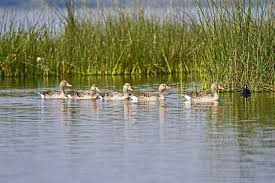India’s Ramsar Site tally touches 91 as two more Rajasthan wetlands gain recognition

India has once again strengthened its commitment to wetland conservation. Two more wetlands from Rajasthan have been officially designated as Ramsar Sites. This recognition brings the country’s total number of Ramsar Sites to 91. It highlights India’s growing dedication to preserving its rich biodiversity and vital ecosystems.
What Are Ramsar Sites?
Ramsar Sites are wetlands of international importance. They are designated under the Ramsar Convention, an intergovernmental treaty established in 1971. The treaty promotes the conservation and sustainable use of wetlands worldwide. Wetlands play a crucial role in supporting biodiversity, regulating water cycles, and providing livelihoods for local communities.
New Ramsar Sites in Rajasthan
The two newly recognized wetlands in Rajasthan are:
- Tal Chhapar Wildlife Sanctuary: Located in Churu district, Tal Chhapar is famous for its blackbuck population and vast grasslands. Additionally, this wetland supports a diverse range of bird species, including migratory waterbirds. Therefore, it is an ecological hotspot for birdwatchers and researchers alike.
- Jawai Dam Wetland: Situated near Jawai Bandh village in Pali district, this wetland supports a variety of flora and fauna, including migratory birds. Moreover, it plays a significant role in the region’s water management. The wetland also provides sustenance for both wildlife and local communities.
Significance of the Recognition
The addition of these two wetlands to the Ramsar list highlights the ecological importance of Rajasthan’s water bodies. Although Rajasthan is mostly arid, its wetlands serve as vital refuges for migratory birds and endemic species. With increasing threats from climate change, pollution, and unsustainable land use, Ramsar recognition helps prioritize their conservation.
India’s Growing Ramsar List
India’s Ramsar Site tally has grown steadily over the years. This reflects the country’s proactive approach to environmental conservation. Key wetlands such as Keoladeo National Park in Rajasthan, Chilika Lake in Odisha, and the Sundarbans in West Bengal have long been part of this prestigious list.
With 91 wetlands now under Ramsar protection, India ranks among the top countries globally for Ramsar designations. This growth not only safeguards critical habitats but also contributes to global efforts to combat biodiversity loss and mitigate climate impacts.
Challenges Ahead
While Ramsar recognition brings international attention and support, wetlands across India still face pressures. Urbanization, industrial development, and climate variability threaten these fragile ecosystems. Therefore, effective management strategies, community engagement, and strong policy enforcement are essential to ensure their survival.
Conclusion
The inclusion of Tal Chhapar Wildlife Sanctuary and Jawai Dam Wetland as Ramsar Sites marks a significant milestone. It reinforces India’s role as a steward of diverse and precious wetland ecosystems. Hence, sustained conservation efforts will be key to preserving these natural treasures, supporting biodiversity, and enhancing local livelihoods.






